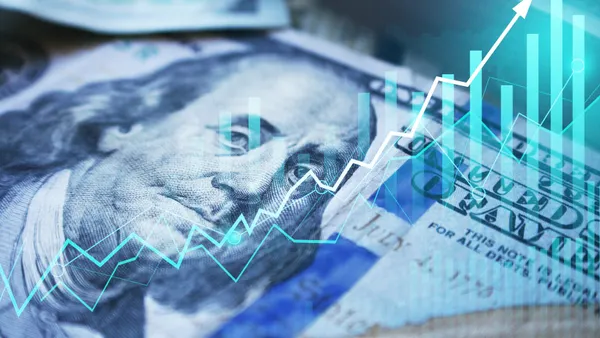Dive Brief:
- The highest tariffs since the 1930s pose a heavy drag on the economy and will slow gross domestic product growth to 1.6% this year, the Conference Board said Thursday, noting that its Leading Economic Index fell more in August than any month since April.
- Import taxes undermined economic growth beginning in the first half of this year and will persist as an impediment into the first half of 2026, the Conference Board said. Declines in new orders at manufacturers, building permits for houses, weekly hours worked in manufacturing and consumer expectations for business conditions all pushed down the index and signal weaker GDP growth ahead, the Conference Board said.
- “A major driver of this slowdown has been tariffs,”Justyna Zabinska-La Monica, senior manager for business cycle indicators at the Conference Board, said in a statement. “Labor market developments also weighed on the index with an increase in unemployment claims,” she said.
Dive Insight:
Federal Reserve Chair Jerome Powell on Wednesday flagged the softening labor market after policymakers trimmed the benchmark interest rate by a quarter point to a range between 4% and 4.25%. Citing weakness in the job market, they forecast two more quarter-point cuts this year.
“Payroll job gains have slowed significantly to a pace of just 29,000 per month over the past three months,” Powell said at a press conference after the Fed policy decision.
“Labor demand has softened and the recent pace of job creation appears to be running below the ‘breakeven’ rate needed to hold the unemployment rate constant,” he said.
“In this less dynamic and somewhat softer labor market, the downside risks to employment appear to have risen,” Powell said.
While warning of risks to jobs, Fed officials in a median projection estimated that they will reduce the federal funds rate to 3.6% by the end of 2025, or 0.3 percentage point lower than their June projection.
Like the Conference Board, central bank officials predict GDP will increase 1.6% this year. They see unemployment rising from 4.3% to 4.5% by the end of this year before easing to 4.4% next year and 4.3% in 2027.
The Fed’s preferred measure of inflation — the personal consumption expenditures price index minus volatile food and energy prices — will likely fall from 3.1% this year to 2.6% next year and 2.1% in 2027, before hitting the central bank’s 2% target in 2028.
Unlike the Conference Board, Powell did not identify tariffs as a drag on growth. Yet he warned that import taxes may prove to be more than just a temporary spur to inflation.
“Higher tariffs have begun to push up prices in some categories of goods, but their overall effects on economic activity and inflation remain to be seen,” Powell said.
“A reasonable base case is that the effects on inflation will be relatively short-lived — a one-time shift in the price level,” he said. “But it is also possible that the inflationary effects could instead be more persistent, and that is a risk to be assessed and managed.”
Noting that GDP growth is headed for “a substantial slowdown from 2.8% in 2024,” Zabinska-La Monica said tariffs “will continue to be a drag on GDP growth in the second half of this year and” during the second half of 2026.
The LEI declined 0.5%, more than forecast, to 98.4 last month after increasing 0.1% in July, the Conference Board said.
The index aggregates 10 components, including average weekly initial claims for unemployment insurance, the Standard & Poor’s 500 stock index and an index of the cost of credit. It is designed to signal turning points in the business cycle about seven months in advance.














